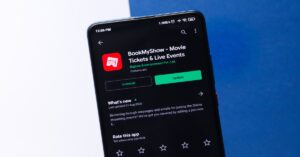ONDC, the Indian government’s ambitious project to democratise online commerce, will go live soon
ONDC will take ecommerce penetration to 40-50% in the coming years, as opposed to the current 10% share within India’s overall retail market: Shireesh Joshi, CBO of ONDC
Despite the initial hype, the project faces a number of challenges, including lack of awareness, scalability issues, tech fine-tuning and data privacy
It took us 10 years to get a billion people to aadhar, 5 years to get UPI to 4 Bn, but ONDC will happen faster than any other transformation that has happen so far and early adopters will benefit. ~ Nandan Nilekani
The Open Network for Digital Commerce (ONDC), an Indian government initiative, is expected to make the network available for public use later this month. Since the pilot phase started in April this year, this first-of-its-kind initiative has been promoted as the UPI moment of Indian ecommerce. It is expected to put around 8 Mn small and mid-size retailers on a more even footing with the likes of Amazon India and Walmart-owned Flipkart, which control more than 60% of the country’s online retail market.
Better still, it has the potential to usher in fair competition in retail if adopted on a global scale.
Sponsored by DPIIT (the Department for Promotion of Industry and Internal Trade), the non-profit programme, will bring together all stakeholders – buyers, sellers, logistics players, and digital payment providers – on one platform for convenience and growth.
For businesses, this will help create a level playing field and further drive open commerce, similar to how the United Payments Interface (UPI) democratised the digital payments segment. Buyers, too, will benefit from easy access to a massive merchant base, great pricing, faster delivery, and enhanced customer experience.
Given the kind of impact platform-centric ‘open networks’ can bring to businesses via its underlying tech, it is not surprising that ONDC is so often touted as the primary channel for online sales in the coming decades. “ONDC is inevitable, and it will take [ecommerce penetration] to 40-50% in the coming years,” Shireesh Joshi, CBO of ONDC told Inc42 in a recent interview.
Similar to how NPCI is leading the $10 Tn worth digital payments ecosystem with more than 103 Bn transactions since 2016, ONDC aims to generate 3 Bn orders per month, bring 15 Bn neighbourhood shops online and sign up 900 Mn digital buyers and reach a gross merchandise value (GMV) of $48 Bn over the next five years. ONDC is expected to be available in 100+ towns and cities across India by late August or early September 2022.
The euphoria has also hit local merchants, often at loggerheads with ecommerce giants over fees and commissions. As many as 200 sellers from around 15 cities have already joined the ONDC project and counting. Interestingly, the grapevine has it that ONDC will keep referral commissions capped at 3-5% at a later stage (for now, it is free), a massive reduction in costs compared to what businesses have to pay now for selling their goods online. According to a Gofrugal estimate, this is 7 to 10 times less than the usual online-selling commission rate of 23% to 28% on the cart value.
In contrast, on the consumer side, ecommerce is still a matter of faith for several consumers. The number of internet connections in 2021 increased significantly to around 830 Mn, which ONDC considers a possible ecommerce market. It claims that only 4-5% (statistics indicate it is 22%) of this market has been captured by existing ecommerce players. Yet, ecommerce giants Amazon and Flipkart together hold over 60% of the present-day market consisting of 190 Mn online shoppers.
Among the Big Tech companies operating here, Microsoft is the first to join ONDC project as it plans to launch a social commerce app in India and wants to leverage the open network to discover the best prices on offer. The US-based tech giant called the network game changer and a win-win for buyers as well as sellers removing dependency on any ecommerce solution.
Despite the positive hype, among people and across the media, naysayers abound while others follow a wait-and-watch policy. The founder and CEO of a Mumbai-based fintech company that works closely with offline retailers and kirana stores in Tier 2 and Tier 3 cities, believes that ONDC is a broken model.
“The scale it is aiming to reach is not possible due to multiple bottlenecks. The involvement of bigger marketplaces like Amazon and Flipkart also makes it a flawed model. It will only add to the troubles of small businesses if adopted in its current format,” he said requesting anonymity.
Faced with conflicting views, Inc42 has decided to take a hard look at the pros and cons to find out if Mission ONDC is really what it seems at first sight.
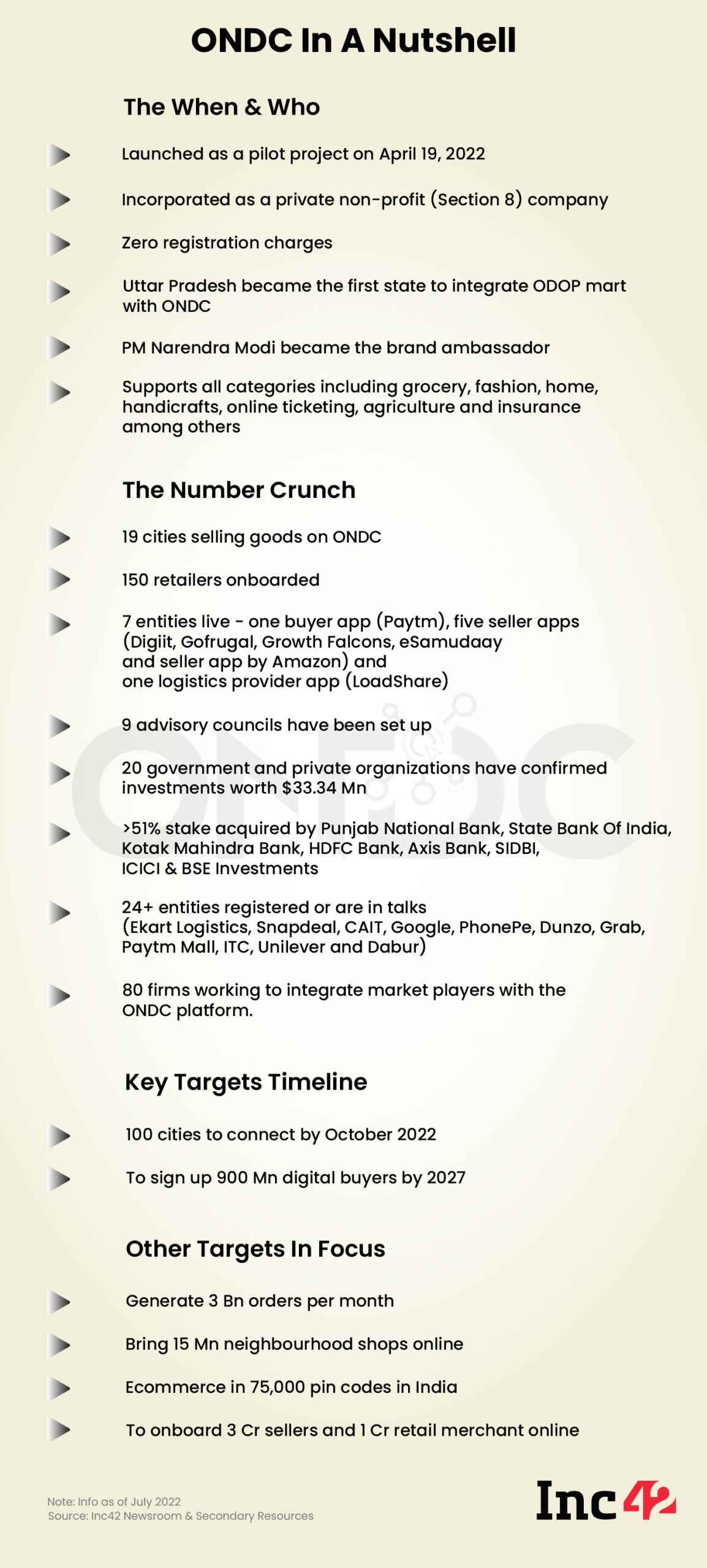
Decoding The ONDC Framework
In simple terms, ONDC is not a platform, application, aggregator or super-app. It is essentially an umbrella organisation offering a communication network or a protocol.
This network aims to democratise digital commerce, moving it from a platform-centric model to an open network for all entities concerned and enabling online order fulfilment between a buyer and seller.
It means ONDC will allow buyers and sellers to be digitally visible and transact through an open network, irrespective of their industry or the platform or application they use. If there is a buyer and a seller has a catalogue from which products/services can be chosen, the ONDC protocol will function.
It is primarily a peer-to-peer (P2P) network also extendable to the B2B (business-to-business) space. “Whether anyone is currently doing ecommerce or not, [they] can be a part of the network and start with the digital commerce journey. That’s the beauty of this platform,” said Manoj Gupta, CEO and founder of Plotch.AI and Craftsvilla, during one of his ONDC presentations.
ONDC Vs Existing Ecommerce Transaction Architecture
Now that we know the basic premises of open ecommerce, let us look at the transactional differences. Traditional ecommerce platforms have a storefront for buyers and a backend for operations. The latter is also connected to a network of sellers/suppliers. Overall, an ecommerce marketplace connects buyers and sellers through its storefront and the backend, while it acts as the intermediary and the arbiter.
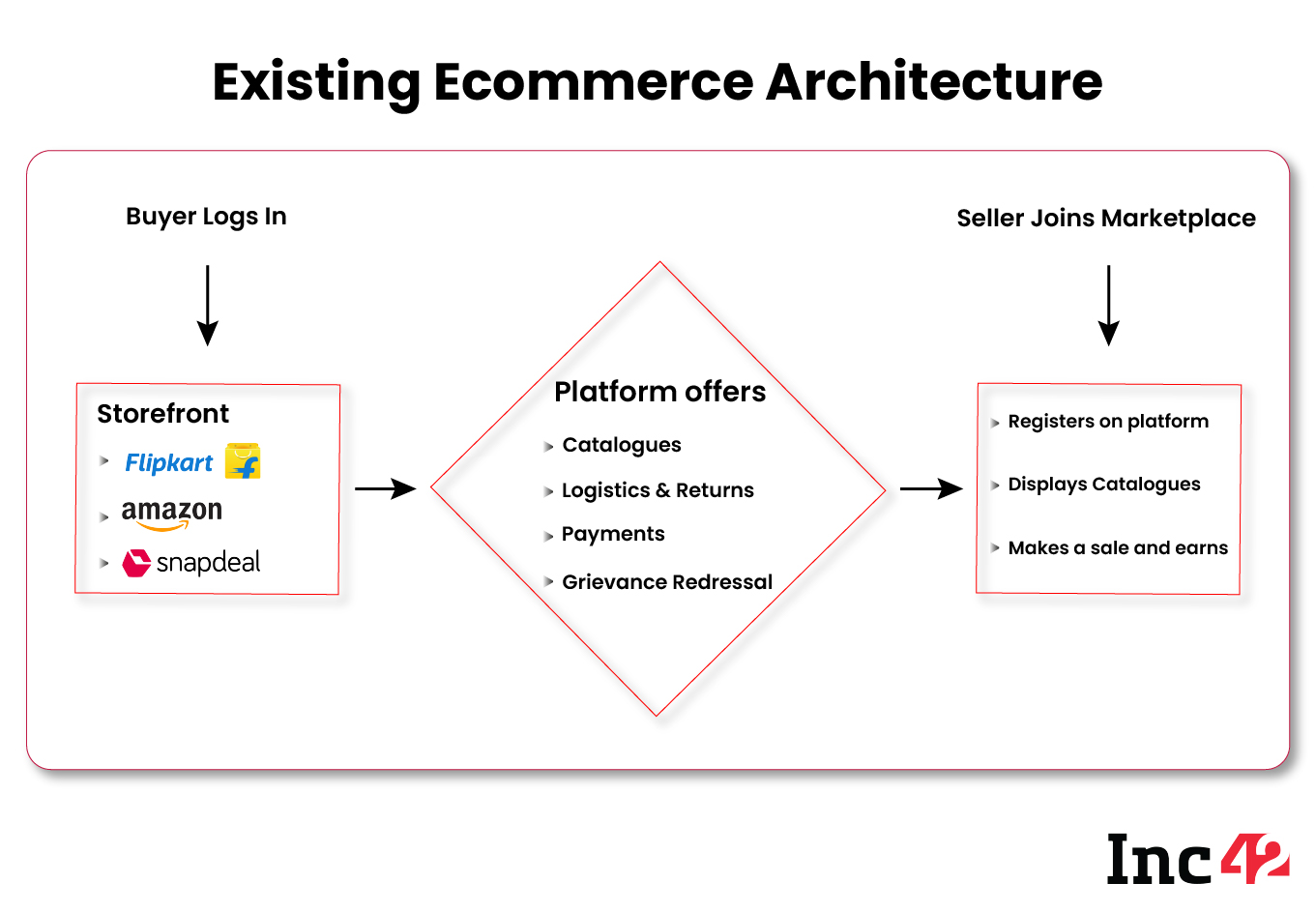
Although the opportunity to sell online to a vast user base can guarantee great growth, the fruits of this business model is primarily enjoyed by a few big players in control of the ecommerce platforms (more on that later). In contrast, ONDC wants to break the existing chain and bring the benefits of democratic selling, embedded ecommerce and market regulated pricings to a wide network of sellers, buyers and the consumer facing platforms.
Being a communication gateway, ONDC enables discovery and search of all business entities registered here. To ensure a smooth information flow, it has come up with a registry where all buyer apps (such as Paytm and PhonePe) and seller apps (such as Amazon, Flipkart and countless small merchants) will fill their data regarding domain name, GST number, company PAN and authorised signatory, among others. This will ensure that only genuine platforms join the network.
Incidentally, there is a reputation ledger in place that logs business rankings based on these parameters, and ONDC reserves the right to take a call on who can offer services and who cannot. A network for logistics providers has also been added to help businesses ship their products.
Buyer apps will manage a host of features such as product search and discovery, order creation and confirmation, special offers and cart management, payment, ONDC registration and more. Similar to the existing scenario, only buyer apps will be responsible for consumer grievance redressal in case of returns or refunds.
Seller apps will include those set up by individual retailers. Alternatively, local businesses can come together to create a neighbourhood or smaller city subnet of manufacturers and retailers and register as a single seller app (for example, an eSamudaay seller app). These apps will manage ONDC registration, respond to initial search queries such as product availability, handle dynamic pricing, and manage settlements and logistics.
This can lead to the emergence of smaller Flipkart’s and Amazon’s from multiple neighbourhoods, eventually unleashing the power of hyperlocal commerce via ONDC.
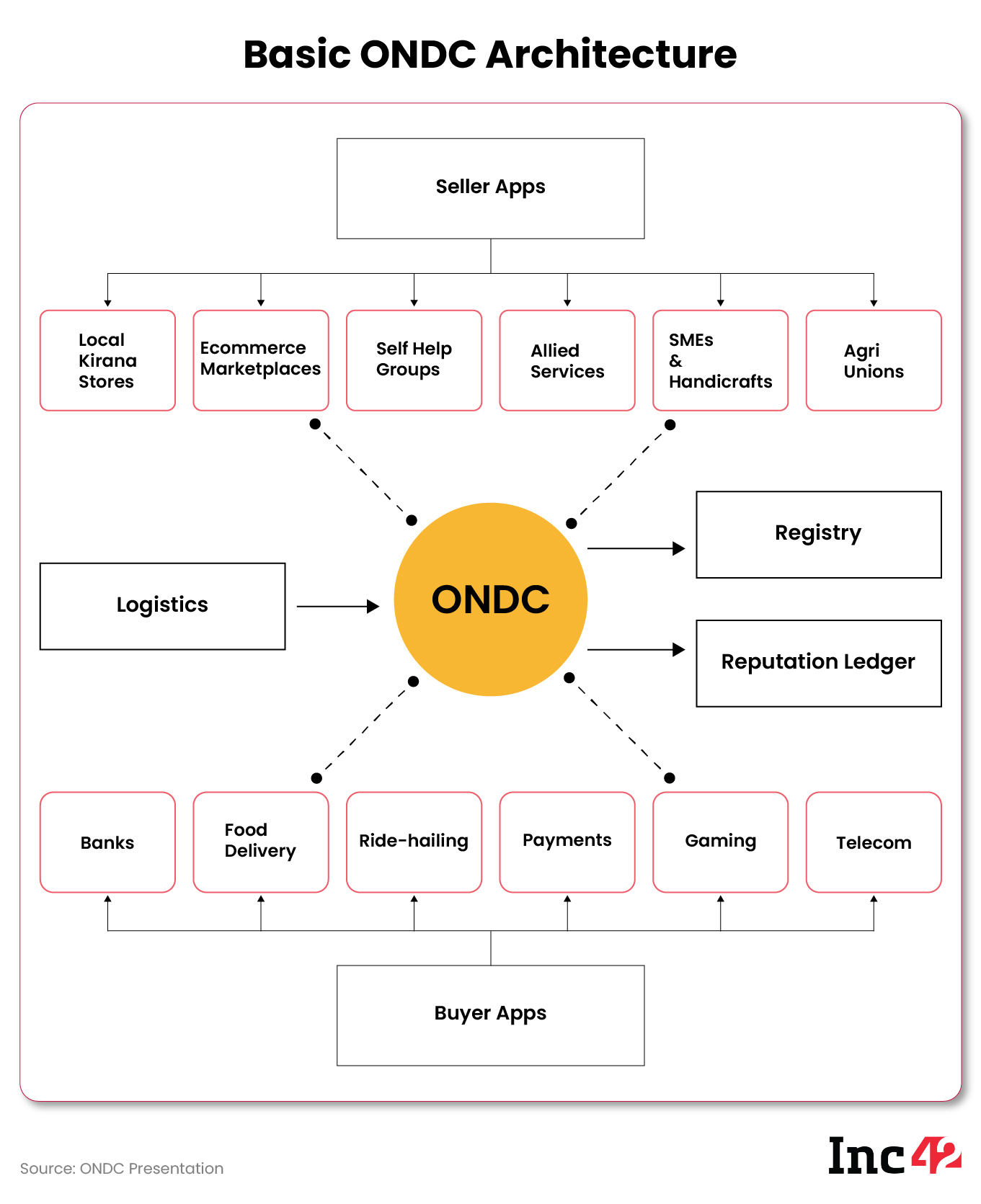
The Buyer-Seller Communication Cycle On ONDC
In an ideal scenario, here is how the typical buyer and seller communication cycle will look like. A consumer searches for product/s on a buyer app. During the product search, a real-time search request will go to all relevant seller apps and the buyer search will produce the most relevant results (based on search term, category, preference and locality). After the buyer selects the product, the same can be added to the cart on the buyer app. Communication goes to that seller site for adding the product to the cart on the seller app.
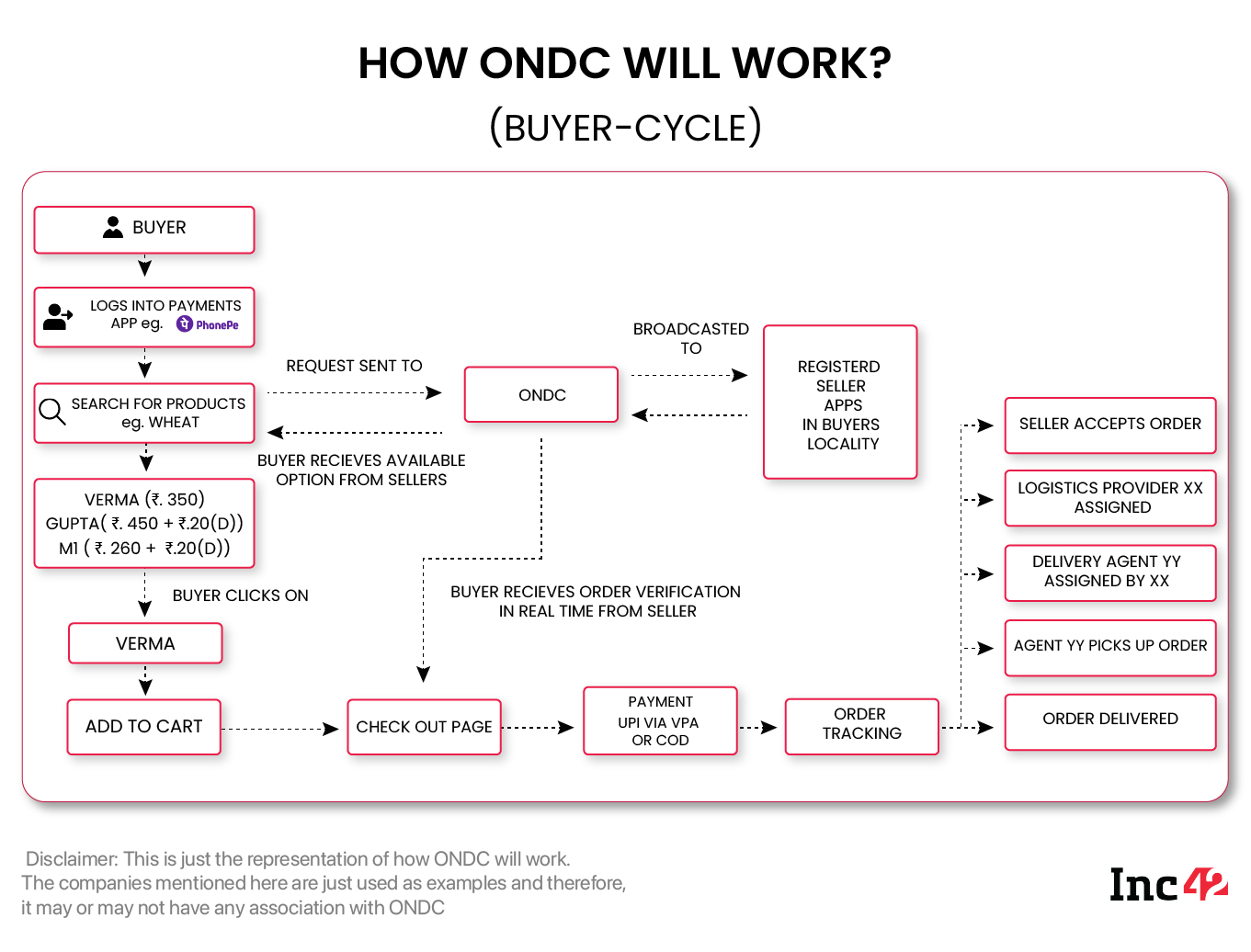
After the buyer finalises the cart and puts the address, a notification goes to the seller app. Next, the seller adds the address to the order page. After order confirmation and payment, proof of the same goes to the seller app. If one buys multiple products from multiple sellers, they see a single cart upfront, but each seller gets a separate notification. Post-transaction, a seller app can identify a suitable logistics partner from the network.
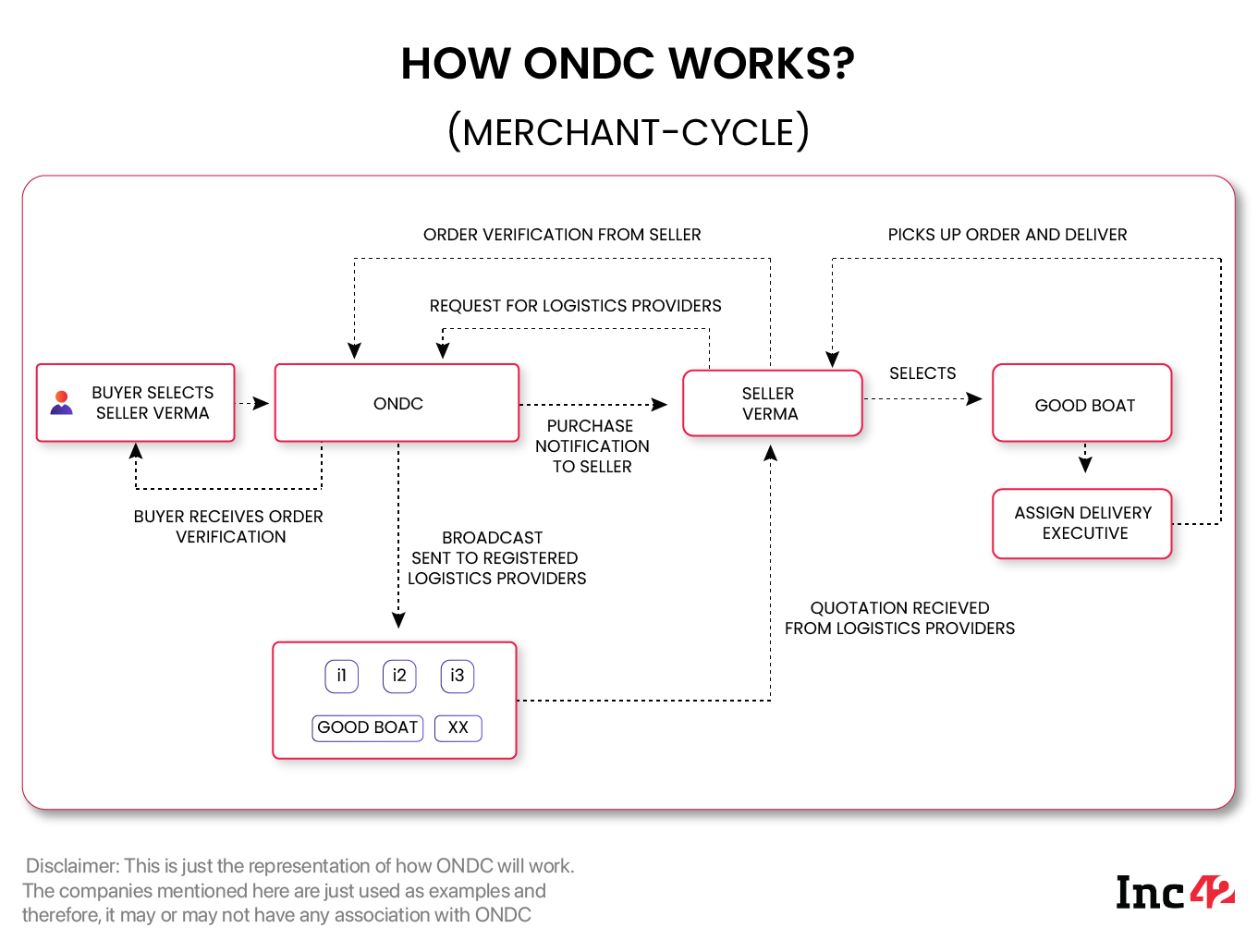
Who Is Building ONDC Tech
According to Joshi of ONDC, the project is currently managed by an in-house tech team that has developed demo apps for buyers and sellers for testing the new apps businesses are developing.
The ONDC specifications communicate over HTTP using Beckn APIs, a set of open network protocols offered by Bengaluru-based NPO Beckon Foundation. These protocols have been issued to build on 58 ONDC transaction use cases, right from search to payment selection to returns and refunds to ratings. Beckon is building a free-to-use interoperable open protocol specification.
Due to the commercial nature of ONDC transactions, every request/callback pair is considered a ‘contract’ between two parties. Therefore, it is imperative that all requests and callbacks are digitally signed by the sender and subsequently verified by the receiver. It is also desirable that the message is not altered or tampered with during transit.
Incidentally, apart from the demo apps and integrating the new buyer and seller apps to the ONDC Registry, the in-house tech team is not offering any further support to developers building these apps.
So, ecommerce SaaS enablers like Mumbai-based Plotch.AI and Chennai-based Gofrugal have stepped in to help with the new apps using the Beckn algo and keeping in mind the essentials of ONDC specifications.
“We have not partnered with the government. But when we became aware of the [ONDC] opportunity, we built the tech at our end. We are now looking to help others who want to join the ONDC network,” said Gupta of Plotch.AI during his interaction.
The Broken Pieces Of The ONDC Puzzle
ONDC is a protocol for changing the face of digital commerce in India. But despite its innovative nature, the model has certain flaws that cannot be ignored if the very purpose of its development is to be justified – that of bringing all neighbourhood retailers to ensure an inclusive digital commerce ecosystem. Here is a quick look at the key challenges we come across while talking to industry experts and analysing the underpinning technology.
Lack Of Awareness
The USP of ONDC is to bring together buyers and sellers on one platform. While a few buyer apps are being registered on ONDC, only big players seem to be entering the seller app ecosystem. So far, Paytm, PhonePe and Microsoft have joined the network as buyer apps.
When we talked to a few merchants selling on marketplaces like Amazon and Flipkart, their response was somewhat sceptical. “Humein kuch nahi pata. Jaisa chalta tha, waisa hi chal raha hai dhandha. (We don’t know anything about ONDC. Business is running as usual.”
Inc42 also got in touch with several kirana owners in Delhi-NCR to understand if they had been contacted by the authorities to set up a local subnet. But none of them were even aware of the ONDC project.
This shows the lack of promotion on the ground to make sure that neighbourhood stores are fully aware of the benefits and the path-breaking impact of ONDC. Moreover, companies need to build multilingual versions of these apps, given the vernacular diversity of the country.
In a meeting with industry stakeholders in June 2022, minister of commerce and industry Piyush Goyal also indicated that ONDC should be made available in regional languages, considering the project’s scale. But unless small sellers understand the network’s utility, it will be a long journey before ONDC can achieve what it wants.
A Commercial Mismatch
With ONDC in the picture, an offline seller looking to join the network must be open to different pricing – one for offline business and another for online transactions.
First, there will be the standard price from the supply end, guaranteeing a profit margin of 5-8% for small retailers. This can go up to 30% depending on the store’s customer outlay. Now, the cost of coming online will be deducted from this profit margin.
Although transactions on ONDC are free at this point, it may charge a transaction fee of approximately 1.5% soon, according to industry sources. While buyer apps will charge a commission of 3-5% on each transaction in the food and beverages and grocery categories, the seller subnet app may also charge a fee to meet the cost of data analytics.
Let us do some maths to get clarity on this. An offline kirana store earning INR 8.25 on a pack of green tea bags priced at INR 165 will now have to pay a minimum of 5%, which will affect its existing supply chain margins, an industry insider told Inc42.
On the other hand, existing ecommerce marketplaces like Amazon and Flipkart and online grocery players like Blinkit, Zepto and Swiggy Instamart are already selling this pack for INR 148 (or less) as opposed to the markup of INR 165, or are using a bundling strategy for deals and discounts. Dynamic real-time pricing has been the key game plan for ecommerce marketplaces for a long time, making product prices drop or surge in line with real-time demand. Given a choice, it is easy to understand where shoppers will head for online buying unless there are price similarities.
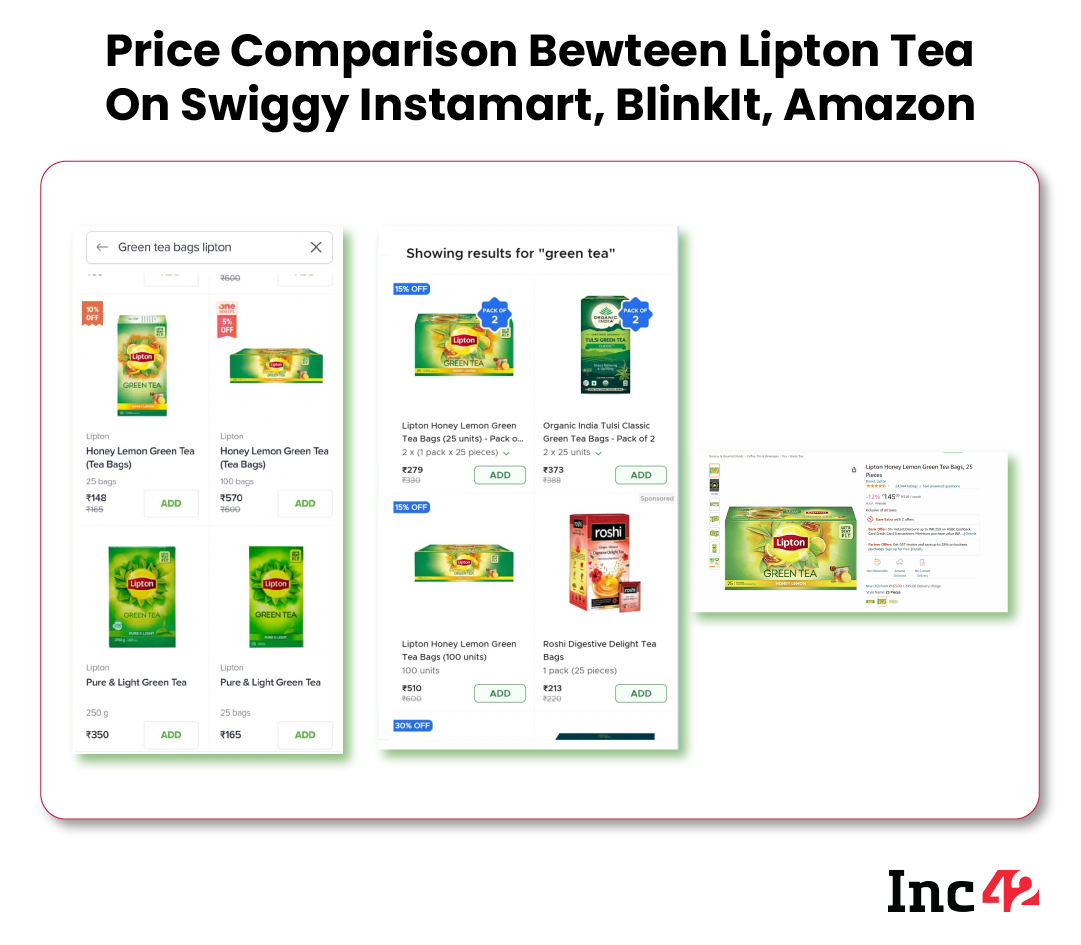
But there’s more. As the algorithms currently support only the F&B and grocery segments, the average ticket size will be low for the online newbies. A look at the ONDC data analytics shows most orders fall below INR 500, thus impacting the unit margins of the newly onboarded retailers until they reach the desired scale.
“If this commercial mismatch is not taken care of, it will be the death of small offline retailers, especially those in the daily essentials space, including grocery and F&B,” said the fintech founder mentioned earlier.
Some may argue that the companies/sellers on the ONDC platform will no longer have to pay high commissions of several intermediaries, which currently charge as much as 30%. But considering the ticket size and the limited capability of small retailers, the price disparity and discount war are bound to hinder them, beating the very purpose of ONDC.
Glitches At The Tech End
According to the existing ONDC specifications, the gateway forward search request from a back-end application will reach all back-end providers registered within that city. Simply put, if a consumer from East Delhi searches for green tea on a buyer app, the search request will be broadcast to all seller apps in the city. Subsequently, the said customer may receive requests from all Delhi-based sellers on the ONDC Registry. This data will be fetched automatically from the seller apps based on previously agreed location-based specifications.
This is similar to a buyer’s search for pizza or restaurants on Swiggy, and the results may vary between 1 and 20 km from the customer’s location. However, this can be cumbersome from the ONDC perspective.
- Long-term scope can be short-term hassle: Seller apps are responsible for a lot of analytics as they receive city-wide searches. In the course of things, these may have to deal with many non-coverage issues due to [remote] location, pricing and turnaround time (TAT). While this data will help businesses expand their stores and services in the future, it will be difficult to track the dashboard in real time for the most relevant search requests or pay a data analytics company to extract actionable insights from the data.
- The dilemma of multiple carts: As Gupta of Plotch.AI explained, a customer may add four products from four different sellers with different delivery timelines. The outcome is rarely satisfactory, as the day will be spent answering the doorbell. In contrast, one will find it more convenient to switch to existing services like Blinkit, Zepto, BigBasket or Swiggy Instamart – where unlike ONDC, these marketplaces give users the option to club orders and deliver the same in one go.
“Also, in this race for visibility and volume – each business will try and fulfil as many requests as possible – sellers may end up biting more than they can chew. There is ‘n’ number of ways this can go south unless this is fixed,” said an industry expert.
Below are the data charts from the ONDC analytics dashboard of Plotch.AI that underline this problem. If we just look at the peak, only two orders came in on July 28 from as many as 5,338 searches.
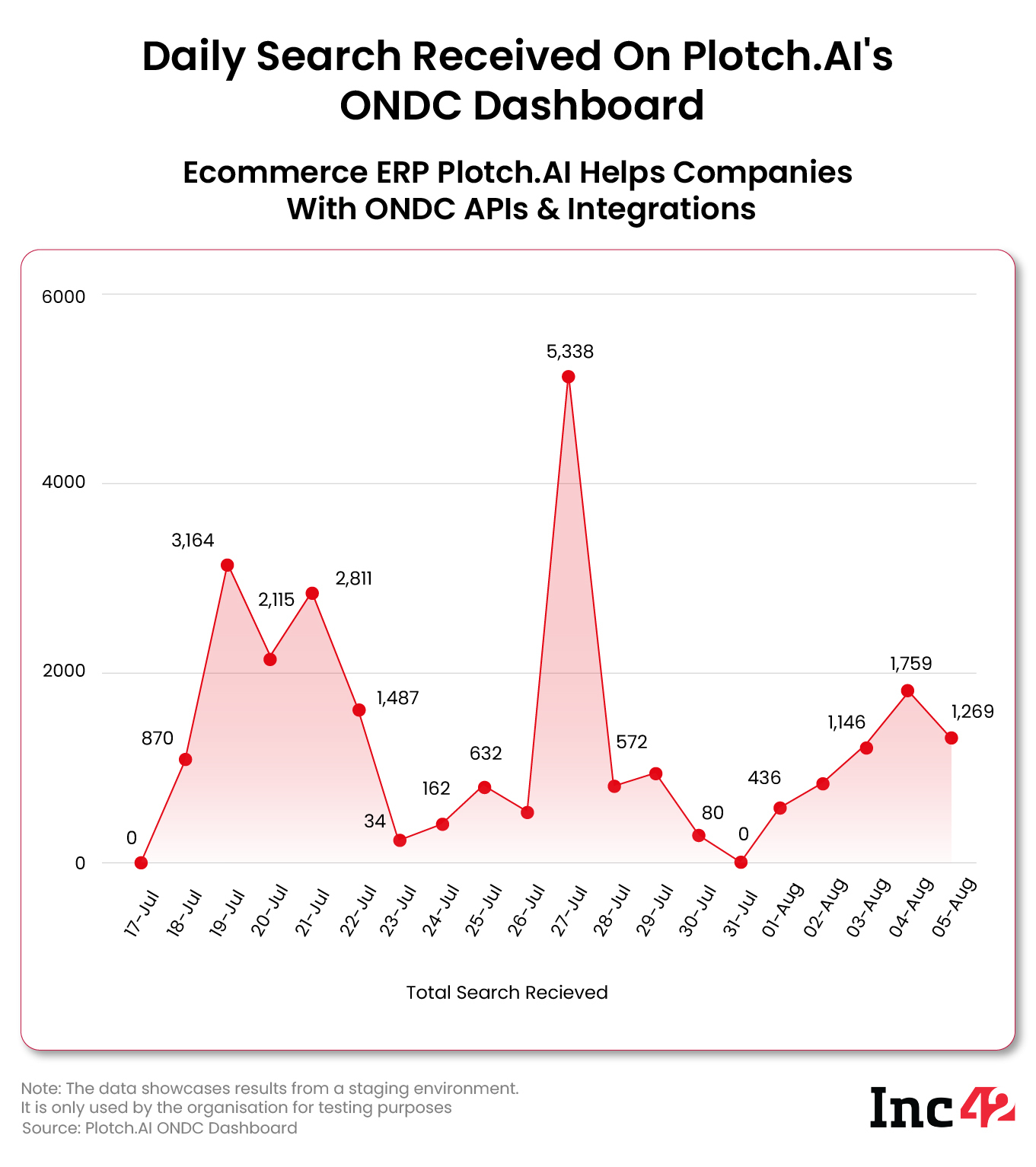
Of course, this data comes from the pilot phase, where actual transactions did not take place. When ONDC goes live pan-India, the number of searches and transactions is bound to grow exponentially. But right now, the response percentage is too low even for sample data.
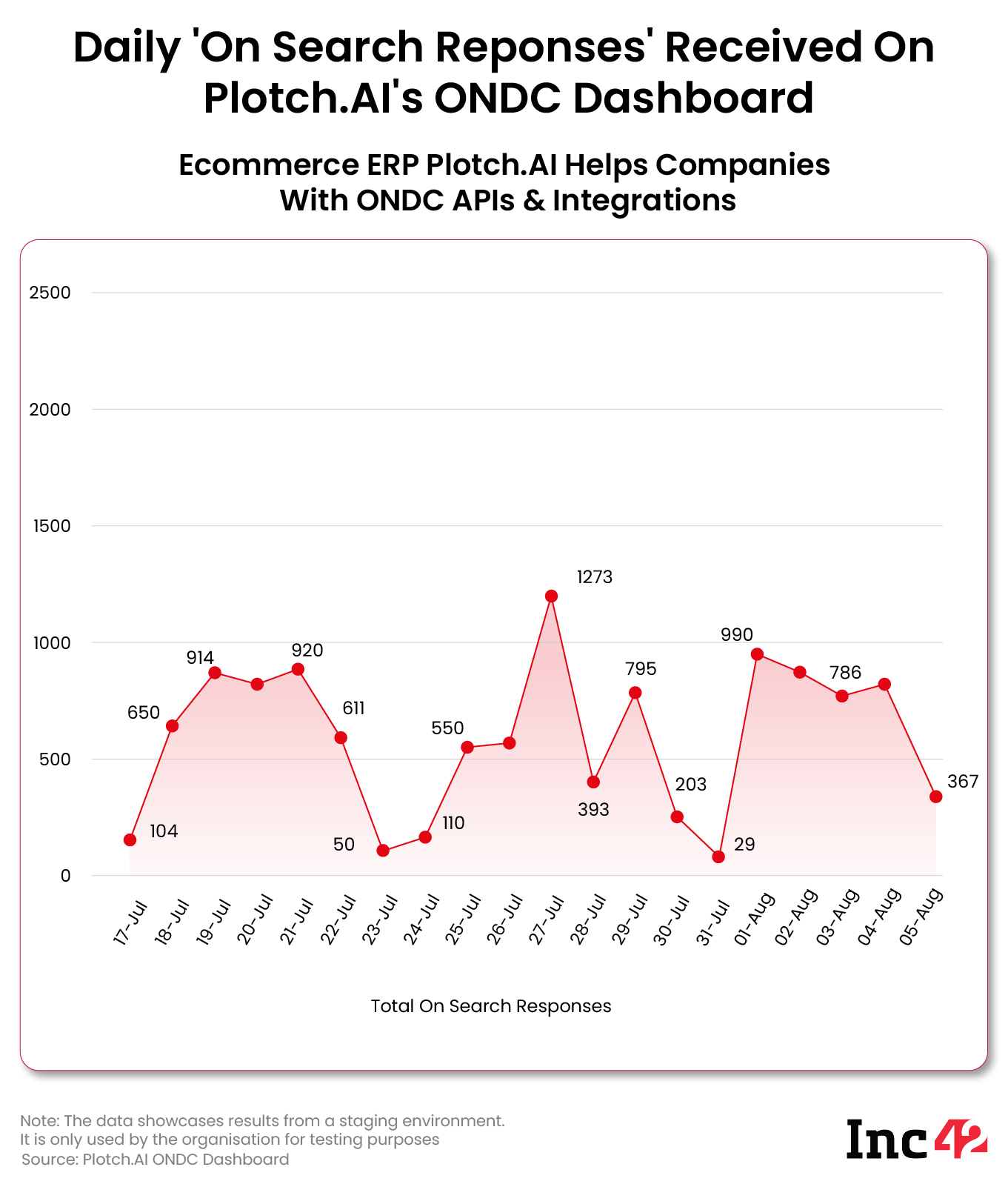
Probably this is why the government has allowed existing ecommerce marketplaces on the ONDC network. That is one way of bringing volume and transaction value. We guess that in the initial phase, the government is more interested in showcasing the number of transactions on the ONDC network,” said the CEO of the fintech startup mentioned earlier.
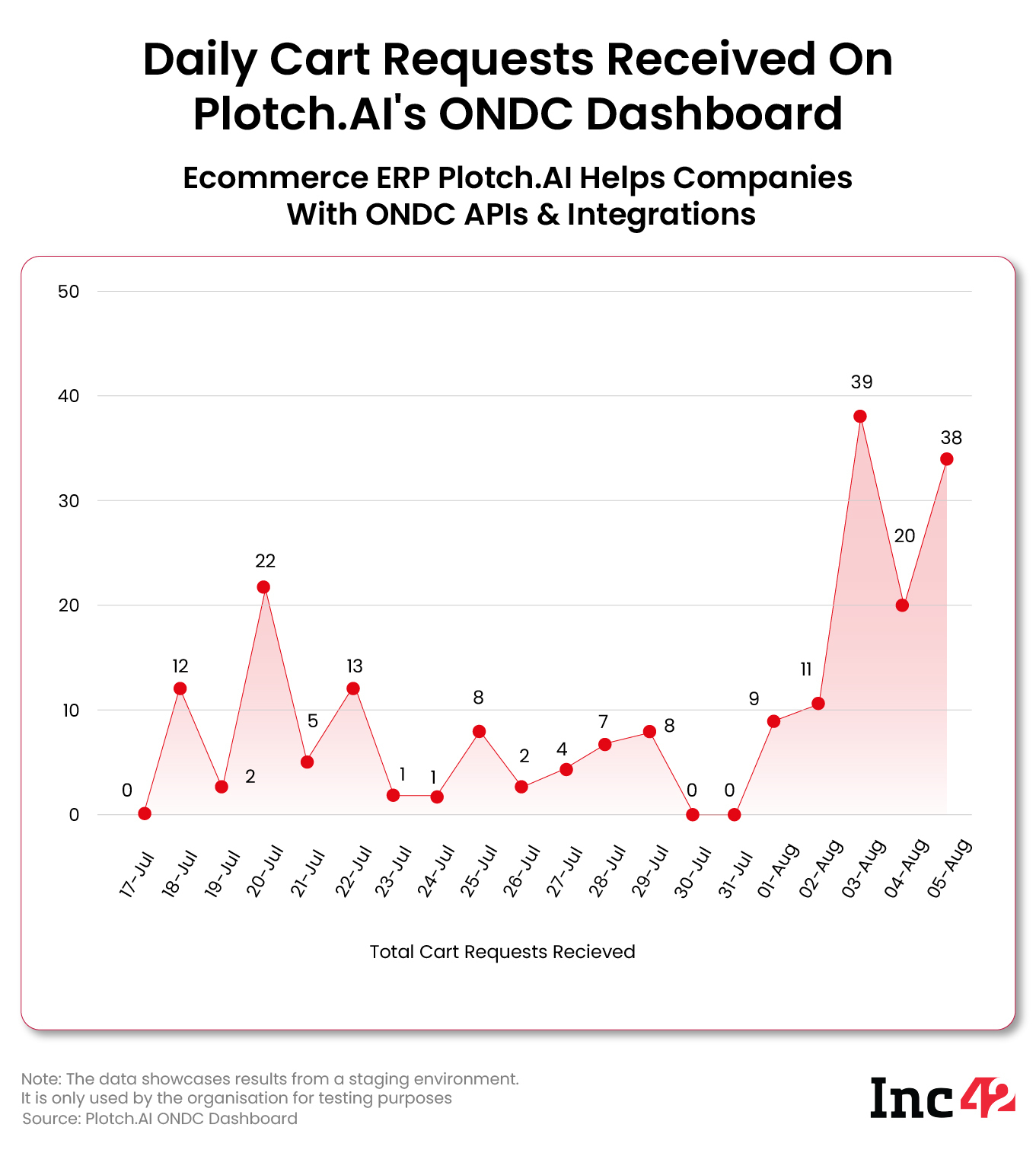
‘Deep’ Networks, New ‘Discount’ Wars May Plague ONDC
Terabytes have been written about how high commissions and a relentless driving down of prices by ecommerce marketplaces have put small retailers at the mercy of deep-pocketed giants like Amazon, Flipkart and their ilk. Then there is the algorithm that helps ‘position’ merchants and their products for better visibility. ONDC aims to remove all that to democratise the marketplace, but surprisingly, the old problems may soon pop up in a new form.
To begin with, even a level playing field may see abysmal price drops due to an overcrowded ecosystem. The search-to-response ratio on ONDC is worrying enough, and it is not clear how the open platform, with a low entry barrier, can control the fight over prices at online marketplaces.
Will the government decide upon price-cut thresholds based on the brand size? Will there be new curbs for large, medium and small or hyperlocal vendors? Or new regulations for those who thrive on the economies of scale alongside a reasonable exemption for the rest who are yet to reach there and currently struggling to cope with the cost of digital metamorphosis?
What’s more worrying is the presence of the deep-pocketed ecommerce giants.
For a long time, the Competition Commission of India (CCI) and trade lobbies like the Confederation of All India Traders (CAIT) have been raising red flags about the practices adopted by major ecommerce marketplaces.
Now that they are joining a new platform with no clarity regarding the possible price wars, these companies can easily adopt a variety of tools and tactics to their benefit, hurting small businesses in the process. Besides, their access to a widespread network of logistics companies and their well-honed capabilities, including low-ticket-size e-selling and delivery, 10-minute delivery and decades of consumer trust building around easy returns and refunds, will make them stand out from the rest.
Even as Amazon and Flipkart are joining ONDC to set up seller apps, one cannot help wondering what all they may sell on the new platform. This will be quite legitimate as all e-retailers can set up both buyer and seller apps on ONDC. If Amazon and Flipkart do the same, the benefits will be manifold. As buyer apps, they can charge commissions on transactions (if it happens in the near future), while the seller apps set up by these companies will drive scale as never before.
Understandably, their private labels will play a key role this time, as they already accounnt for over 25% of their overall sales. Both have been known to push their private labels to turn them into powerhouse brands, and there can be no better opportunity to reach out to Bharat via ONDC.
Interestingly, the seller registry on ONDC is practically shared with every buyer app. Thus, the complete list may easily become a source of predatory and hardcore selling proposition for any firm that has the Yellow Pages equivalent of a seller directory. Consequently, Amazon and Flipkart, that work on onboarding sellers via a subscription-cum-commission model, can leverage the registry to get hold of more than 7.9 Mn SMEs in the country.
Another question that looms is whether the merchants selling on Amazon and Flipkart can be listed on the ONDC Registry as this may lead to data privacy issues such as sharing of any transaction-level data and other performance metrics. Industry sources say that on the buyer app, the product will list as Amazon and Flipkart and not individual sellers. This way, it will alllow the ecommerce giants’ data to keep their sellers data hidden and to themselves.
But that will only add another link to the chain to the simplified process of ecommerce. Where currently the chain is buyer – ecommerce app – seller, the newer chain will be buyer – buyer app – seller app (Amazon/Flipkart) – seller. The government has not yet added a clause to this effect, though.
“It would have been more apt if these players were kept out of ONDC to make it more small retailer-centric, with the government adding transaction charges as per their capacity. We hope that more and more state governments will set up their state marts here, and the government will push things further to ensure a level playing field,” said the aforementioned fintech CEO.
There will be another set of competitors in ONDC’s digital mix. These are none other than the offline and deep-pocketed FMCG players like ITC, Dabur and Unilever, currently in talks with ONDC. Is it possible that the ecommerce war zone will shift from Amazon versus Flipkart to Amazon-Flipkart versus offline retail giants, with SMEs playing second fiddle much like before? Or will ONDC fire India’s newfound enthusiasm for digital-first D2C brands and truly bring in a small-retail revolution?
Accountability Remains A Grey Area
The current ecommerce module pins consumer liability on storefronts, but on the ONDC platform, it rests with seller apps. Surprisingly, the ONDC guidelines fail to provide much clarity regarding issue resolutions, whether delivery-related, payment-related or product return-related, even though the project’s success will largely depend on the scale and require high-volume resolution.
While large ecommerce players such as Paytm setting up seller apps on the ONDC platform do not lack adequate resources to maintain accountability and enhance customer service journey, small-scale subnets and individual sellers, especially those going digital for the first time, will have fewer resources and less expertise. Given the efficient and seamless return/refund operations carried out by the likes of Amazon and Flipkart versus new-to-the-business D2C players facing initial glitches, online shoppers are more likely to opt for the former.
The entire legal and accountability landscape of ecommerce on ONDC remains a gray area, and a Parliament Committee Report has also highlighted the issue. The report titled ‘Promotion and Regulation of E-Commerce in India, June 2022’ states that ONDC’s strategy paper is silent on the subject of liability on the network in case consumers face issues regarding transactions and delivery of substandard products and services.
In July 2022, the government proposed that the seller apps would be responsible for resolving all customer grievances in the first instance. Customers can approach an ONDC-approved third-party dispute resolution platform if they are still dissatisfied.
“However, this is also a white space, wherein we may expect the emergence of a host of companies to help resolve customer grievances for the buyer apps. This is a challenge for now but nothing that cannot be solved,” said Gupta of Plotch.AI.
Can India Do A Taobao Powered By ONDC?
Over the past two decades, ecommerce in India has undergone many innovative changes. From the onset of online commerce in 1999 with Fabmart to the successful launch of Flipkart and Snapdeal in 2007 and 2010, respectively to the rise of D2C in the wake of the Covid-19 pandemic in 2020 – the basic business model has used different sets of levers to sync with evolving times. It has been the launchpad for several niche sectors and business models including hyperlocal and quick commerce, online grocery, food delivery, logistics tech, ecommerce SaaS and dukaantech, among others.
The growth story has been outstanding. Projected to be a $400 Bn market by 2030, the sector boasts 23 unicorns worth $28.72 Bn, 1.8K+ investors and 5K+ active startups, 128 Mn+ online shoppers and nearly 3 Mn registered sellers and service providers.
But as Joshi of ONDC told Inc42, active businesses in this space currently cover less than 10% of the overall retail opportunity, and ONDC is the answer to fulfilling this gap. “The ONDC protocol will add interoperability that was missing hitherto and will bring the remaining 90% of the population (who do not use ecommerce) to its digital fold,” he added.
The inclusivity of India’s online retail can also usher in new business models like China’s Taobao. Owned by Alibaba, this marketplace provides a platform for small businesses and individual entrepreneurs to open online stores and mainly cater to the Chinese-speaking population at home and abroad while payments are made online. This is similar to what ONDC aims to achieve but on an open network.
Of course, naysayers cite different examples. Many think that turning every consumer-facing platform into a marketplace has not been entirely successful here, although the likes of CRED, Paytm Mall and MobiKwik have given it their best shot. Simply put, the scale of ‘embedded ecommerce’ is far from desirable at this point.
But the point to note here is the concerted effort taken for the first time. As Piyush Goyal pointed out, local traders’ associations should be involved in the exercise and necessary measures for awareness generation and capacity-building of various stakeholders would be taken. Besides, various service sector players – the gig workers, agripreneurs, insurers and more – can leverage the ONDC protocols to connect with their target audiences, thus widening the project’s scope.
For instance, ONDC and the National Bank for Agriculture and Rural Development (NABARD) are working on a programme to bring the network to the agriculture sector with the belief that ONDC may be an invaluable tool to assist farmers in finding the right prices for their produce. India has struggled to offer a single agri market for all agricultural and allied products for a long time. But a solution may not be elusive anymore.
Although the project is the Centre’s initiative, state governments are also joining forces to push it pan-India. ONDC is in conversation with many states and has conducted workshops with Tamil Nadu and Kerala governments. It has also helped the Uttar Pradesh government set up a One District One Product (ODOP) mart on the platform. In the future, more states will launch their marts to promote local artisans and the retailers’ ecosystem.
“So definitely we are working with several arms of the government departments, IT teams, startups, SMEs, manufacturers, the agri team and several other segments on multiple fronts,” added Joshi.
Unshackling ecommerce from its current format will not be an easy task. But India did it once when it launched BHIM-UPI in 2016 to democratise how digital payments were done. In less than six years, the technology has been adopted by the UAE, Nepal and Bhutan, and it is likely to go live in Singapore later this year.
Can ONDC turn out to be another local success story gaining global acceptance? We will continue to chart its progress after its official launch in the public domain.
Stay tuned for insights into ecommerce 3.0 and beyond.
[With inputs from Sanghamitra Mandal]

![You are currently viewing [Explainer] How India’s Ambitious ONDC Project Can Reinvent Indian Ecommerce](https://blog.digitalsevaa.com/wp-content/uploads/2022/08/social-1-1-1.png)




